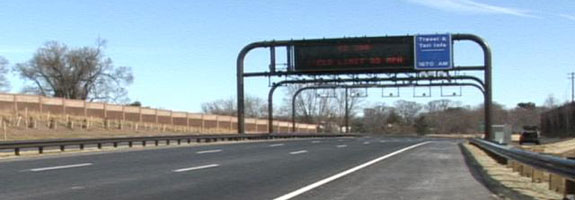
Some cities and states are experimenting with tolls lanes on congested commuter highways to cut commute times. The new lanes are called HOT lanes, which stands for High Occupancy Toll. Highway officials argue the new policy gives a choice to crawl along in traffic or get in the fast lane.
State Department of Transportation officials around the country tell reporters they see toll lanes as a crucial way to generate revenue in an era of tight budgets. But they have not generated the revenue they expected, even though they like the idea of managing traffic by adjusting prices. However, the economics of HOT Lanes guarantees the desire to raise revenue works against their ability to ease traffic congestion.
The Wall Street Journal reports 21 HOT lanes open around the country. [“Life in the Fast Lane, at a Cost”, WSJ, Nov 29, 2013] Road planners require a transponder mounted in commuter’s cars that allow charging a toll that can be varied depending on traffic, but admit tolls as high as $.90 a mile in the Atlanta HOT lanes have kept revenue and use down. Some who object to the charges call HOT lanes “Lexus Lanes” useful to the well-to-do who can afford high tolls.
It is important to remember the only reason to pay for a trip in a HOT lane is to save time. If the fees go down that does encourage more use of the lanes, but it also means the HOT lanes will be more congested and potentially raise trip times. It also suggests the free lanes will be less congested and lower trip times for the free users.
In Virginia along I-95, officials have promoted car pooling by reserving 2 lanes as HOV lanes of three or more people while leaving 3 lanes open to all traffic. To show how well the 14 mile car pool lanes work, they released a compilation of information of several recent years about respective travel times from 6:30 AM to 9:30 AM.
The two HOV-3 lanes carried an average 31,700 people in 8,600 cars at an average time of 29 minutes. The three open lanes carried 23,500 people in 21,300 cars at an average time of 64 minutes. The HOV-3 lanes allowed a savings of 35 minutes with an average of 4,300 cars per lane, but the unrestricted lanes were badly congested with 7,100 cars per lane.
The system of car pool lanes has operated for many years without tolls, which officials say they want to keep, but in addition to allow single or two occupancy cars to switch into the HOV3 lanes by paying a toll. Officials in Virginia are suggesting a toll of $5 to $7 dollars is needed for the 14 mile trip on I-95, but the higher the fee, the fewer the riders and the less the revenue.
Lower fees will not raise revenue unless the percentage increase in riders is greater than the percentage decrease in the tolls. However, the bigger the increase of riders they get to switch, the more quickly the fast lanes will get congested and raise travel times in the HOT lanes and defeat the program.
Everything about the proposals so far indicates fees will have to be high to keep travel times down. High tolls mean HOT lanes work primarily for the well-to-do that do not, or cannot, carpool or worry about travel expenses. In the mean time road planners will have to decide whether they want to allocate scare travel space to the highest bidder or raise revenue for road budgets. They can’t do both.
 About the author: Fred Siegmund covers America's jobs as part of work doing labor market analysis and projections for a client base of recruiters, trainers and counselors. Visit him at www.americanjobmarket.blogspot.com
About the author: Fred Siegmund covers America's jobs as part of work doing labor market analysis and projections for a client base of recruiters, trainers and counselors. Visit him at www.americanjobmarket.blogspot.com



